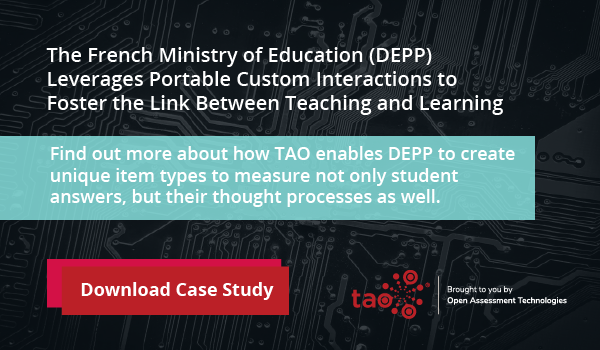For educators, connecting assessment to learning is a vital part of ensuring that students are motivated and engaged in learning, and that they have a clear understanding of what they need to know. When assessments align with learning objectives, they provide valuable feedback that informs instructional design and allows for personalized learning. All of this leads to an increase in student growth and achievement and gives the instructor a clear picture of how students are growing in relation to the standards.
In many cases, educators may use an assessment as learning. This type of assessment generally happens in the middle of a unit or lesson and is designed as a formative assessment where the teacher can identify learning gaps or misconceptions and make corrections quickly. All of this means that there is a quick connection between assessment and the learning that has happened during the lesson.
However, in large-scale summative assessments, such as unit exams, mid-terms, or year-end tests, it may be more difficult to connect the test items directly to student learning. Having a set list of test item categories is essential in this situation. Educators may link questions to learning objectives, concepts, or difficulty, giving them the flexibility to look at data with more intention and purpose. Traditionally, this would have been difficult as assessment was paper-based, however, with robust online testing platforms, like TAO, educators can analyze critical data quickly to make decisions in real-time.
Data Drives Instruction and Learning
Data is critical in driving instruction and learning because it provides valuable insights and evidence that inform decision-making and lead to more effective educational practices. Educators may use data to drive instruction and learning in several key ways, including:
Informed Decision-Making: Data-driven instruction allows educators to make well-informed decisions about curriculum design, teaching methods, and learning resources. By analyzing data on student performance and progress, teachers can tailor their instructional strategies to meet the specific needs of individual students or the class as a whole.
Personalized Learning: Data enables the implementation of personalized learning approaches. By understanding students’ strengths, weaknesses, and learning preferences, educators can create customized learning paths that optimize student engagement and success.
Identifying Learning Gaps: Data helps identify learning gaps and areas where students may be struggling. This early identification allows for timely interventions and support and additional opportunities for assessment as learning, preventing learning difficulties from becoming more significant obstacles.
Monitoring Progress: Through data analysis, educators can continuously monitor student progress. This ongoing assessment enables them to gauge the effectiveness of their teaching methods and make adjustments when necessary.
Feedback for Students: Data provides valuable feedback to students about their academic performance. By understanding their strengths and areas for improvement, students can take ownership of their learning journey and work towards achieving their goals.
Continuous Improvement: Data serves as a foundation for continuous improvement in learning. By analyzing trends and patterns over time, educators can identify successful practices and areas that need enhancement, fostering a culture of ongoing improvement.
Evidence-Based Practices: Data helps educators adopt evidence-based teaching practices. By relying on data-backed insights, educators can implement strategies that have proven to be effective in supporting student learning.
Meeting Individual Needs: Data-driven instruction allows teachers to differentiate instruction to meet the diverse needs of their students. This ensures that every student has an opportunity to succeed and reach their full potential.
Although using and exploring large data sets is critical for educators, it is perhaps more important to learn how to sort through data to make meaningful observations. One way of doing this is by intentionally setting up test categories that enable metadata information to be easily understood.
Enabling Metadata Capabilities
Metadata enables educators to group and look at test questions and student information from a variety of high-view lenses. It allows educators to break down student understanding to a more basic and granular level.
By using a powerful online testing platform, like TAO, educators can design assessment items and link them to custom identifiers. After students have taken the assessment, educators can then pull data based on any identifiers linked to each question. These could include identifiers such as standard, level of difficulty, or type of question (open-ended, fact-based, etc.). With cloud-based testing platforms, this can be done quickly and efficiently, revealing patterns and seeing growth in ways that simply weren’t possible in the past.
Benefits of Linking Test Items to Custom Metadata Identifiers
Linking test items to custom identifiers offers several benefits in the context of assessment and evaluation including:
Flexible Assessment Management: Custom metadata identifiers allow educators to organize and manage test items according to their unique preferences. This flexibility makes it easier to categorize, search, and retrieve specific test items, streamlining the assessment creation process.
Curriculum Alignment: By linking test items to custom identifiers representing specific learning objectives or standards, educators can ensure that assessments align closely with the curriculum. This alignment helps in measuring the attainment of desired knowledge and skills.
Targeted Learning Outcomes: Custom identifiers enable the creation of assessments tailored to target specific learning outcomes or competencies. This targeted approach ensures that assessments assess precisely what students are expected to learn.
Item Analysis and Review: Custom identifiers facilitate item analysis by categorizing test items based on specific attributes (e.g., difficulty level, cognitive domain, or topic). This categorization aids in the review and improvement of assessments over time.
Assessment Balance: Using metadata, educators can ensure that assessments are balanced and cover a diverse range of topics, skills, and cognitive levels. This balance contributes to a more comprehensive evaluation of students’ knowledge and abilities.
Consistent Scoring and Grading: Custom identifiers can be used to group items with similar scoring criteria or rubrics. This consistency in scoring and grading ensures fairness and reliability in the assessment process.
Data Analysis and Reporting: When test items are linked to custom metadata identifiers, data analysis becomes more efficient. Educators can generate targeted reports on students’ performance in specific learning areas, enabling data-driven decision-making.
Long-Term Assessment Management: Custom identifiers aid in maintaining a well-organized assessment bank over time. As educators create and update assessments regularly, custom identifiers facilitate easy retrieval and management of items for future use.
Developing a Metadata Strategy
Using assessment as learning and leveraging real-time data requires a bit of upfront work and creating a metadata strategy. Putting in this work upfront allows test items to be used and improved year to year and class to class. Before starting, the educator should take some time to think about which categories they need and how they can be most impactful.
For example, an educator may look at each test item and assign it to a specific learning objective from the unit. Before giving the exam the teacher could look it over and see if there are any objectives that are over or under-represented on the exam, which could tilt the final result. After the exam, the educator can look at the specific results and class data for each objective and see if any patterns emerge. This is also a good time to circle back and reteach if needed.
Another strategy that teachers may use is to differentiate learning and assessment based on student needs including language or cognitive needs. Teachers may look for patterns that show where more support is needed. Educators may also look at metadata between teachers or even grade levels, when common assessments are given, to see if there are areas of strength or weakness within a larger data set of students. This is also a great area for teacher collaboration as it makes it easy to share what works and improve what doesn’t.
Closing
Data-driven instruction is critical to student learning. Having the capabilities afforded by a robust online testing platform like TAO testing, educators can develop testing materials and categorize test items to pull large data sets after giving an assessment.
By pinpointing student growth, improving teacher efficiency, and leveraging large amounts of data teachers can improve student achievement and utilize assessment as learning with ease. To learn more about how TAO testing can help your school or district to leverage student metadata, click here.


